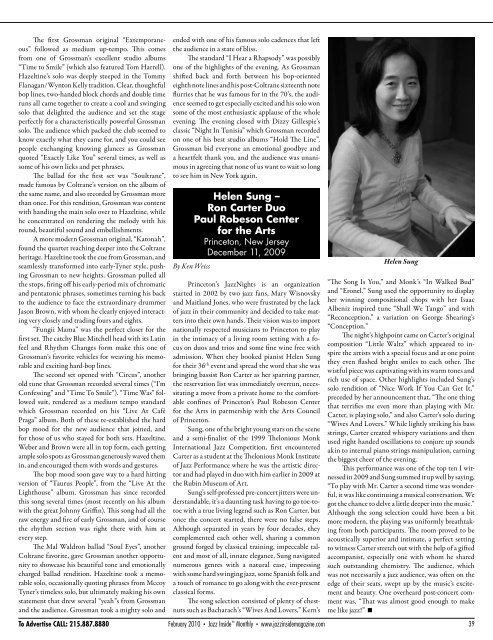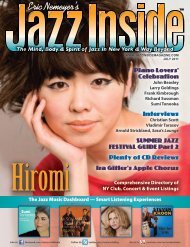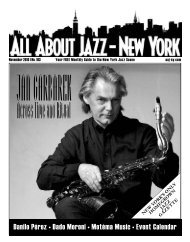February 2010 issue - Jazz Singers.com
February 2010 issue - Jazz Singers.com
February 2010 issue - Jazz Singers.com
Create successful ePaper yourself
Turn your PDF publications into a flip-book with our unique Google optimized e-Paper software.
The first Grossman original “Extemporaneous”<br />
followed as medium up-tempo. This <strong>com</strong>es<br />
from one of Grossman’s excellent studio albums<br />
“Time to Smile” (which also featured Tom Harrell).<br />
Hazeltine’s solo was deeply steeped in the Tommy<br />
Flanagan/Wynton Kelly tradition. Clear, thoughtful<br />
bop lines, two-handed block chords and double time<br />
runs all came together to create a cool and swinging<br />
solo that delighted the audience and set the stage<br />
perfectly for a characteristically powerful Grossman<br />
solo. The audience which packed the club seemed to<br />
know exactly what they came for, and you could see<br />
people exchanging knowing glances as Grossman<br />
quoted “Exactly Like You” several times, as well as<br />
some of his own licks and pet phrases.<br />
The ballad for the first set was “Soultrane”,<br />
made famous by Coltrane’s version on the album of<br />
the same name, and also recorded by Grossman more<br />
than once. For this rendition, Grossman was content<br />
with handing the main solo over to Hazeltine, while<br />
he concentrated on rendering the melody with his<br />
round, beautiful sound and embellishments.<br />
A more modern Grossman original, “Katonah”,<br />
found the quartet reaching deeper into the Coltrane<br />
heritage. Hazeltine took the cue from Grossman, and<br />
seamlessly transformed into early-Tyner style, pushing<br />
Grossman to new heights. Grossman pulled all<br />
the stops, firing off his early-period mix of chromatic<br />
and pentatonic phrases, sometimes turning his back<br />
to the audience to face the extraordinary drummer<br />
Jason Brown, with whom he clearly enjoyed interacting<br />
very closely and trading fours and eights.<br />
“Fungii Mama” was the perfect closer for the<br />
first set. The catchy Blue Mitchell head with its Latin<br />
feel and Rhythm Changes form make this one of<br />
Grossman’s favorite vehicles for weaving his memorable<br />
and exciting hard-bop lines.<br />
The second set opened with “Circus”, another<br />
old tune that Grossman recorded several times (“I’m<br />
Confessing” and “Time To Smile”). “Time Was” followed<br />
suit, rendered as a medium tempo standard<br />
which Grossman recorded on his “Live At Café<br />
Praga” album. Both of these re-established the hard<br />
bop mood for the new audience that joined, and<br />
for those of us who stayed for both sets. Hazeltine,<br />
Weber and Brown were all in top form, each getting<br />
ample solo spots as Grossman generously waved them<br />
in, and encouraged them with words and gestures.<br />
The bop mood soon gave way to a hard hitting<br />
version of “Taurus People”, from the “Live At the<br />
Lighthouse” album. Grossman has since recorded<br />
this song several times (most recently on his album<br />
with the great Johnny Griffin). This song had all the<br />
raw energy and fire of early Grossman, and of course<br />
the rhythm section was right there with him at<br />
every step.<br />
The Mal Waldron ballad “Soul Eyes”, another<br />
Coltrane favorite, gave Grossman another opportunity<br />
to showcase his beautiful tone and emotionally<br />
charged ballad rendition. Hazeltine took a memorable<br />
solo, occasionally quoting phrases from Mccoy<br />
Tyner’s timeless solo, but ultimately making his own<br />
statement that drew several “yeah”s from Grossman<br />
and the audience. Grossman took a mighty solo and<br />
ended with one of his famous solo cadences that left<br />
the audience in a state of bliss.<br />
The standard “I Hear a Rhapsody” was possibly<br />
one of the highlights of the evening. As Grossman<br />
shifted back and forth between his bop-oriented<br />
eighth note lines and his post-Coltrane sixteenth note<br />
flurries that he was famous for in the 70’s, the audience<br />
seemed to get especially excited and his solo won<br />
some of the most enthusiastic applause of the whole<br />
evening. The evening closed with Dizzy Gillespie’s<br />
classic “Night In Tunisia” which Grossman recorded<br />
on one of his best studio albums “Hold The Line”.<br />
Grossman bid everyone an emotional goodbye and<br />
a heartfelt thank you, and the audience was unanimous<br />
in agreeing that none of us want to wait so long<br />
to see him in New York again.<br />
By Ken Weiss<br />
Helen Sung –<br />
Ron Carter Duo<br />
Paul Robeson Center<br />
for the Arts<br />
Princeton, New Jersey<br />
December 11, 2009<br />
Princeton’s <strong>Jazz</strong>Nights is an organization<br />
started in 2002 by two jazz fans, Mary Wisnovsky<br />
and Maitland Jones, who were frustrated by the lack<br />
of jazz in their <strong>com</strong>munity and decided to take matters<br />
into their own hands. Their vision was to import<br />
nationally respected musicians to Princeton to play<br />
in the intimacy of a living room setting with a focus<br />
on duos and trios and some fine wine free with<br />
admission. When they booked pianist Helen Sung<br />
for their 36 th event and spread the word that she was<br />
bringing bassist Ron Carter as her sparring partner,<br />
the reservation list was immediately overrun, necessitating<br />
a move from a private home to the <strong>com</strong>fortable<br />
confines of Princeton’s Paul Robeson Center<br />
for the Arts in partnership with the Arts Council<br />
of Princeton.<br />
Sung, one of the bright young stars on the scene<br />
and a semi-finalist of the 1999 Thelonious Monk<br />
International <strong>Jazz</strong> Competition, first encountered<br />
Carter as a student at the Thelonious Monk Institute<br />
of <strong>Jazz</strong> Performance where he was the artistic director<br />
and had played in duo with him earlier in 2009 at<br />
the Rubin Museum of Art.<br />
Sung’s self-professed pre-concert jitters were understandable,<br />
it’s a daunting task having to go toe-totoe<br />
with a true living legend such as Ron Carter, but<br />
once the concert started, there were no false steps.<br />
Although separated in years by four decades, they<br />
<strong>com</strong>plemented each other well, sharing a <strong>com</strong>mon<br />
ground forged by classical training, impeccable talent<br />
and most of all, innate elegance. Sung navigated<br />
numerous genres with a natural ease, impressing<br />
with some hard swinging jazz, some Spanish folk and<br />
a touch of romance to go along with the ever-present<br />
classical forms.<br />
The song selection consisted of plenty of chestnuts<br />
such as Bacharach’s “Wives And Lovers,” Kern’s<br />
Helen Sung<br />
“The Song Is You,” and Monk’s “In Walked Bud”<br />
and “Eronel.” Sung used the opportunity to display<br />
her winning <strong>com</strong>positional chops with her Isaac<br />
Albeniz inspired tune “Shall We Tango” and with<br />
“Reconception,” a variation on George Shearing’s<br />
“Conception.”<br />
The night’s highpoint came on Carter’s original<br />
<strong>com</strong>position “Little Waltz” which appeared to inspire<br />
the artists with a special focus and at one point<br />
they even flashed bright smiles to each other. The<br />
wistful piece was captivating with its warm tones and<br />
rich use of space. Other highlights included Sung’s<br />
solo rendition of “Nice Work If You Can Get It,”<br />
preceded by her announcement that, “The one thing<br />
that terrifies me even more than playing with Mr.<br />
Carter, is playing solo,” and also Carter’s solo during<br />
“Wives And Lovers.” While lightly striking his bass<br />
strings, Carter created whispery variations and then<br />
used right handed oscillations to conjure up sounds<br />
akin to internal piano strings manipulation, earning<br />
the biggest cheer of the evening.<br />
This performance was one of the top ten I witnessed<br />
in 2009 and Sung summed it up well by saying,<br />
“To play with Mr. Carter a second time was wonderful,<br />
it was like continuing a musical conversation. We<br />
got the chance to delve a little deeper into the music.”<br />
Although the song selection could have been a bit<br />
more modern, the playing was uniformly breathtaking<br />
from both participants. The room proved to be<br />
acoustically superior and intimate, a perfect setting<br />
to witness Carter stretch out with the help of a gifted<br />
ac<strong>com</strong>panist, especially one with whom he shared<br />
such outstanding chemistry. The audience, which<br />
was not necessarily a jazz audience, was often on the<br />
edge of their seats, swept up by the music’s excitement<br />
and beauty. One overheard post-concert <strong>com</strong>ment<br />
was, “That was almost good enough to make<br />
me like jazz!”<br />
To Advertise CALL: 215.887.8880 <strong>February</strong> <strong>2010</strong> • <strong>Jazz</strong> Inside Monthly • www.jazzinsidemagazine.<strong>com</strong> 39




